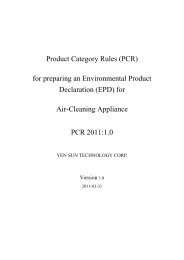Download(PDF) - PCR Library
Download(PDF) - PCR Library
Download(PDF) - PCR Library
Create successful ePaper yourself
Turn your PDF publications into a flip-book with our unique Google optimized e-Paper software.
Annex D (normative): Aluminum can disposal and recycling scenarios<br />
Aluminum can scenarios applied to this <strong>PCR</strong> are below.<br />
D.1 Disposal and recycling flow<br />
The figure below shows the used aluminum can disposal and recycling flow.<br />
Used<br />
aluminum can<br />
Figure D.1 Disposal and recycling flow of used aluminum can<br />
D.1.1 Disposal and recycling rates<br />
The aluminum can recycling rate is based on the value provided by the Japan Aluminum Can Recycling<br />
Association in FY2008.<br />
a) Recycling rate R1: 87.3%<br />
b) Can-to-can rate R2: 66.8%<br />
D.1.2 Disposal and recycling stage<br />
Among aluminum cans that are collected as waste material (1-R1), 46% are subject to final disposal after<br />
intermediate treatment 2, and 54% are subject to final disposal without any intermediate treatment. Therefore,<br />
GHG emissions in processes up to final disposal are included in the disposal and recycling stage.<br />
For aluminum cans (R1) collected as recyclable waste, include GHG emissions of transport A and intermediate<br />
treatment 1 in the disposal and recycling stage.<br />
For manufacturing of plates for aluminum cans, if GHG emissions are calculated based on "aluminum plates<br />
(3004 can body material)" specified in the Database of GHG Emission Factors for the CFP Pilot Project in the<br />
container/packaging raw material acquisition stage, do not include GHG emission of die-cutting scrap metals. This<br />
is because processing of die-cutting scrap metals has already been excluded from the GHG emission factor.<br />
Source: "Study Report on Life Cycle Assessment of a Container and Packaging in FY2004" by the Institute for<br />
Policy Sciences, Japan (published in March 2005)<br />
D.1.3 Direct impact<br />
a) Collecting primary activity data from manufacturing of plates for aluminum cans<br />
Include GHG emissions of transport and the subsequent processes (transport from intermediate treatment<br />
facilities and recycling) of used aluminum cans ready for recycling in the container/packaging raw material<br />
acquisition stage.<br />
Calculate the amount of recycled metal that is not going to be used as can material so that the sum of the<br />
amount of recycled metal to be used as can material (direct impact) and the amount of recycled metal that is not<br />
going to be used as can material (indirect impact) is equal to the industry standard. If the calculation results in a<br />
negative value, review the calculation method.<br />
b) Using the GHG emission factor to calculate GHG emissions in manufacturing of plates for aluminum cans<br />
-18-<br />
Body plate<br />
manufacturing<br />
Recycling rate: R1 Recyclable garbage<br />
Intermediate Transport<br />
Recycling ito<br />
pprimary aluminum<br />
collection<br />
treatment 1<br />
B<br />
secondary<br />
production<br />
Transport A<br />
aluminum<br />
Deduction of the<br />
indirect impact<br />
Disposal<br />
1-R1<br />
Recycling scenario<br />
Waste material<br />
collection<br />
Transport C<br />
Disposal scenario<br />
54%<br />
46%<br />
R2×0.2<br />
Intermediate<br />
treatment 2<br />
Transport<br />
D<br />
1-R2×0.2<br />
Transport<br />
E<br />
Recycling rate:<br />
95% of metal weight<br />
Final disposal<br />
R2×0.8×0.95<br />
Dross and unknown<br />
materials<br />
(1-R2×0.2)×0.05<br />
(1-R2)×0.95















